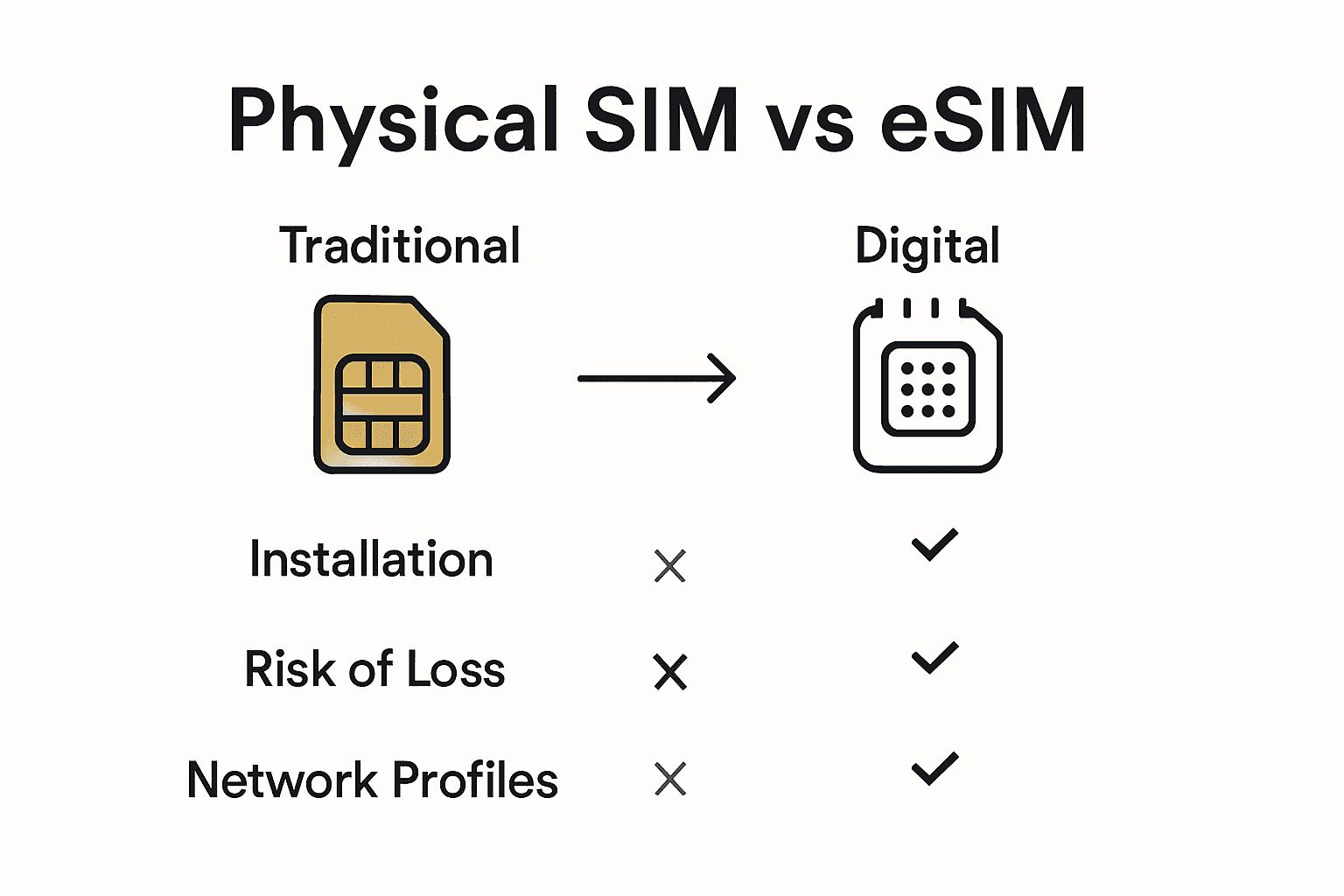Did you know that over 62 percent of international travelers now rely on travel SIMs to stay connected abroad? Staying in touch on the go is more important than ever and the right travel SIM can spare you unexpected roaming fees and hours of hassle. As travel SIM technology moves beyond traditional cards to flexible digital eSIMs, understanding how these solutions work could save you time, money, and stress before your next trip.
Key Takeaways
| Point | Details |
|---|---|
| Travel SIM Benefits | A travel SIM provides cost-effective international communication and immediate network access, simplifying connectivity abroad. |
| Physical vs eSIM | Consider the advantages of eSIM technology, such as multiple profiles and no physical SIM to lose, for more convenient travel. |
| Activation Process | Follow specific activation steps for either physical SIMs or eSIMs to ensure a seamless setup before your trip. |
| Common Mistakes | Avoid assuming universal device compatibility and legal considerations; prepare prior to travel to prevent connectivity issues. |
What Is a Travel SIM and How It Works
A travel SIM is your digital passport to seamless global connectivity. Unlike standard mobile SIM cards restricted to one network, these specialised cards are designed for international travellers who need reliable mobile data and communication across different countries. Learn how to choose the best international travel SIM card before your next adventure.
Traditionally, travel SIMs function as roaming-enabled mobile network solutions. According to research, a roaming SIM operates on multiple networks, automatically switching between available networks domestically and internationally to maintain consistent connectivity. This means you won’t need to manually swap physical SIM cards or hunt for local carrier stores when travelling.
Travel SIMs come in two primary formats:
- Physical Travel SIM Cards: Traditional removable SIM chips you insert into your smartphone
- eSIM Technology: Programmable digital SIM embedded directly into modern devices
The eSIM represents a significant technological advancement. According to Wikipedia, it’s a programmable SIM card embedded directly into a device, allowing remote SIM provisioning without physically swapping cards. This technology supports multiple network profiles, offering unprecedented flexibility for international travellers.
The key advantages of using a travel SIM include:
- Cost-effective international communication
- Immediate network access upon arrival
- Simplified mobile connectivity across borders
- Reduced risk of expensive roaming charges
Types of Travel SIMs: Physical vs eSIM
Travellers today have two primary options for mobile connectivity: physical SIM cards and eSIM technology. Dive into the details of eSIM vs physical SIM to understand which might suit your travel needs best.
Traditional physical SIMs are removable microchips that you manually insert into your mobile device. According to research from Telekonek, these cards are single-profile and require physical handling. They’ve been the standard mobile connectivity solution for decades, requiring travellers to physically swap cards when changing networks or countries.
Physical SIM Characteristics
- Requires manual insertion into device
- Single network profile
- Physically replaceable
- Higher risk of loss or damage
In contrast, eSIM technology represents a significant technological leap. As research from Orange News highlights, eSIMs are digitally integrated directly into devices, offering several advantages:
eSIM Advantages
- Digitally activated via QR code or app
- Support multiple network profiles
- No physical card to lose
- Remote activation and deactivation
- Improved device design without SIM card slots
The primary difference lies in flexibility. Physical SIMs demand manual swapping and carry a higher risk of loss, while eSIMs provide seamless, instant international roaming with just a few digital taps. For modern travellers seeking convenience and technological efficiency, eSIM is rapidly becoming the preferred connectivity solution.

Here’s how physical SIMs and eSIMs compare for travellers:

| Feature | Physical SIM Card | eSIM Technology |
|---|---|---|
| Installation | Manual insertion | Digital QR code/app |
| Network Profiles | Single profile | Multiple profiles |
| Risk of Loss | Higher | None |
| Activation Method | Replace SIM, restart phone | Remote, no physical swap |
| Device Slot Required | Yes | No |
| Convenience for Travel | Lower—swap in every country | Higher—auto switch, instant on |
Step-by-Step Travel SIM Activation Process
Activating your travel SIM requires a slightly different approach depending on whether you’re using a physical or eSIM. Read our comprehensive guide on choosing the right travel SIM card to ensure a smooth setup process.
For eSIM activation, the process is remarkably straightforward. According to research from Travel eSIM, the typical steps include:
- Purchase your chosen international data plan
- Receive a digital activation QR code
- Scan the QR code using your smartphone’s settings
- Enable mobile data roaming for the new eSIM profile
Physical SIM Card Activation
With traditional physical SIM cards, activation involves a few more hands-on steps:
- Remove your existing SIM card
- Insert the new travel SIM carefully
- Follow carrier-specific activation instructions
- Restart your device to complete the process
According to Mobile SIM Blog, eSIM installations are unique because they add a secondary data plan without replacing your existing mobile service. Most travel eSIM plans automatically activate when you connect to the destination network, so it’s recommended to install the eSIM before your trip and activate it upon arrival.
Pro Tips for Smooth Activation
- Always check device compatibility before purchasing
- Have your passport or travel documents ready
- Ensure your phone is unlocked for international use
- Test your new SIM before leaving home
Whether you choose an eSIM or physical SIM, preparation is key to ensuring uninterrupted mobile connectivity during your travels.
Troubleshooting Common SIM Activation Issues
Despite the simplicity of modern travel SIM technology, activation challenges can occasionally arise. Learn how to properly recharge and manage your prepaid SIM card to minimize potential connectivity issues.
Timing and Activation Challenges
One of the most common activation complications relates to timing. According to Mobile SIM Blog, eSIM activation policies vary significantly between providers. Some eSIMs activate immediately upon installation, while others only become active when connecting to the destination network.
Key Activation Troubleshooting Steps
- Verify provider-specific activation requirements
- Check device compatibility before purchasing
- Confirm roaming settings are correctly configured
- Ensure sufficient credit or data plan is purchased
Common Connectivity Issues
- No Signal: Restart device and toggle airplane mode
- Incorrect APN Settings: Manually update network settings
- Partial Activation: Contact customer support for verification
- Unexpected Charges: Monitor data usage and plan details
Prevention and Preparation
To minimize activation headaches, take these proactive steps:
- Screenshot all activation instructions
- Keep customer support contact information handy
- Test SIM functionality before international travel
- Understand your specific plan’s activation window
Remember, most activation issues can be resolved with patience and careful communication with your mobile provider.
Mistakes to Avoid During SIM ActivationActivating a travel SIM isn’t always as straightforward as it seems. Check out our 7-step SIM card selection checklist to help you avoid common pitfalls that could disrupt your mobile connectivity.
Device Compatibility Blunders
One of the most critical mistakes travellers make is assuming universal device support. According to research from Orange News, not all devices or regions are eSIM-friendly. Before your trip, verify:
- Your smartphone’s eSIM compatibility
- Regional eSIM availability in your destination
- Carrier support for digital SIM technology
Legal and Regulatory Risks
Some destinations have strict regulations around mobile connectivity. A shocking example comes from travel reports highlighting regions like Turkey, where eSIM activation within the country is completely banned. This means you must:
- Complete eSIM setup before departure
- Research local telecommunications laws
- Have a backup communication plan
- Avoid last-minute activation attempts
Timing and Preparation Mistakes
Common activation errors include:
- Waiting until arrival to purchase SIM
- Failing to unlock your smartphone
- Overlooking roaming settings
- Ignoring data plan restrictions
Pro Prevention Tips
To ensure smooth mobile connectivity:
- Test your SIM before international travel
- Keep digital and physical activation instructions
- Understand your specific plan’s limitations
- Have customer support contacts readily available
Remember, a little preparation goes a long way in preventing frustrating connectivity issues during your travels.
Get Your Travel SIM Sorted Before You Fly
Dealing with mobile connectivity overseas often means headaches like struggling with activation steps, timing your plan right, or worrying about device compatibility. These common travel SIM challenges do not need to spoil your trip. With SimCorner, you can avoid last-minute stress and keep your phone working smoothly all around the world.
Why choose us?
- Fast online ordering with instant eSIM delivery or tracked shipping for physical SIMs
- Clear step-by-step instructions to avoid activation mistakes
- Plans for every destination and device, so you always stay connected

Ready for hassle-free activation and instant mobile data when you land? Visit the SimCorner homepage right now and discover our full range of travel SIM solutions. Make sure to check out our tips on how to choose the best international travel SIM card before you buy. Simplify your next adventure with SimCorner and step off the plane fully prepared.
Frequently Asked Questions
What is a travel SIM and how does it work?
A travel SIM is a specialized mobile SIM card designed for international travellers, allowing them to connect to multiple networks without needing to swap physical SIM cards. It provides cost-effective communication and immediate network access in different countries.
What are the differences between a physical SIM card and an eSIM?
A physical SIM card is a removable chip that requires manual insertion into a device and supports a single network profile. In contrast, an eSIM is a digital SIM embedded in the device, allowing for multiple network profiles and remote activation without physical swapping.
How do I activate my travel SIM?
Activation varies between physical SIM cards and eSIMs. For physical SIMs, you insert the SIM card and follow carrier instructions. For eSIMs, you scan a QR code provided upon purchase, and enable mobile data roaming in your device settings.
What should I do if I encounter activation issues with my travel SIM?
If you experience activation problems, check your provider’s specific requirements, confirm device compatibility, and ensure roaming settings are correctly configured. Restarting your device or contacting customer support can also help resolve issues.


